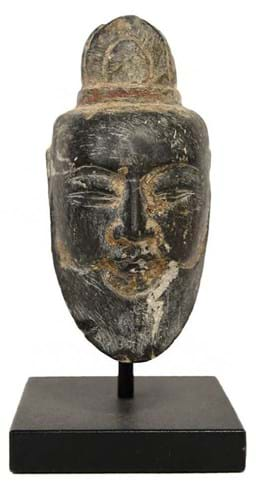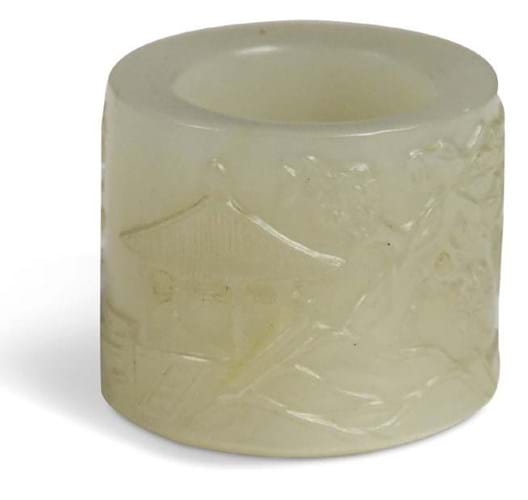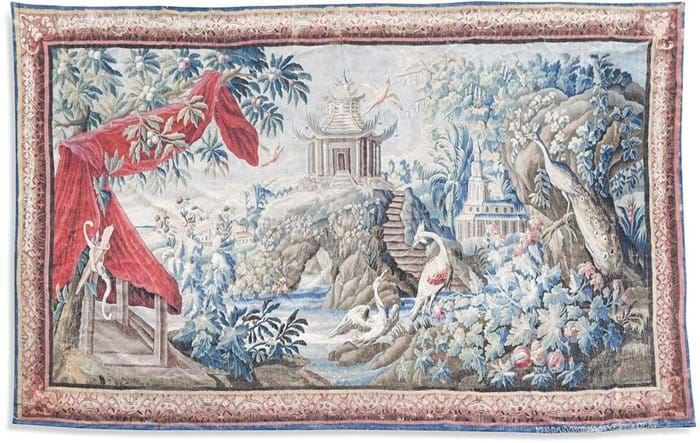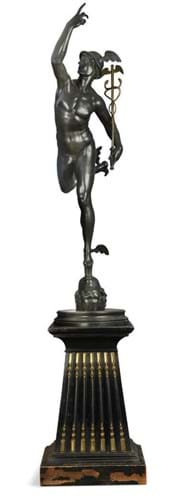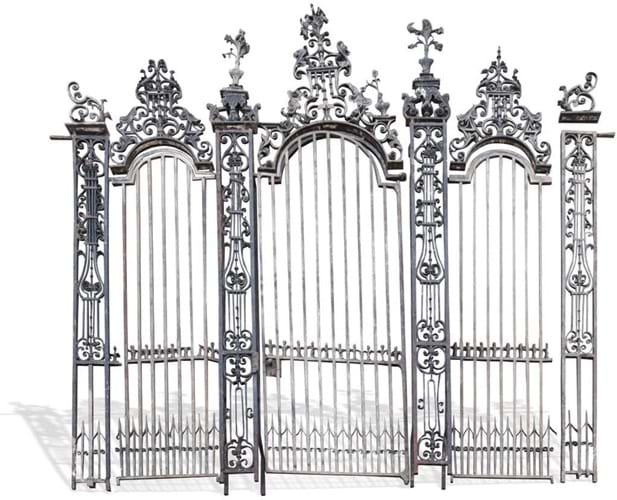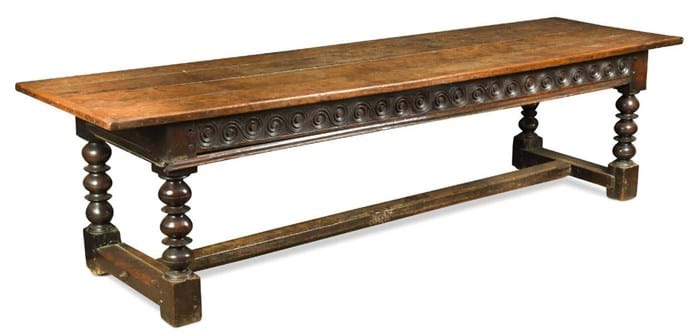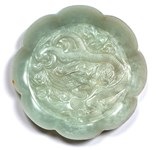Standing 10½in (27cm) and dated c.1920-30, the jovial god had some slight factory firing smudges to the enamelled rear but, against a £300-500 estimate, it went to a private Mainland buyer at £5500.
“There doesn’t seem to be any slowdown in demand due to the situation in Ukraine or the slowdown in the Chinese economy,” said Cheffins’ Asian art expert Adam Schoon. “In fact, around 80% of the Asian art section sold directly to Mainland China.”
Among such purchases were a Kangxi brushpot, and a possibly 6th/7th century Buddhistic stone head.
The 5¾in (14.5cm) high famille verte brushpot, painted with a figure in a pavilion watching a punt on a lake, had a crudely reglued chunk at the back and was sold ‘as found’ but took a six-times-estimate £3200.
The 3¾in (9.5cm) black stone head of Laozi, although with full documentation since being imported from Hong Kong in 2003, would need further checks by buyers before being exported outside the UK or EU. However, against a £150-250 estimate, it sold to a Beijing dealer at £4800.
Jade top-seller
Chinese underbidders were beaten by a London collector to the best-seller: a Qing archer’s ring of mutton-fat jade.
The Qing 18th or 19th century ring of the type made as guards to protect bowmen’s thumbs, was worked in relief with a tea pavilion and rows of calligraphy. In very good condition, it was estimated at £400-600 and sold online at £11,000.
The disappointment of the section was a famille rose vase with a Jiaqing seal mark and probably of the period (1796-1820). Featuring dragon and lingzhi handles, the 12½in (31cm) tall ovoid vase was the second most-viewed lot on Cheffins’ website before the sale but on the day bidding fell short of the £40,000-60,000 estimate.
This was not, believes Schoon, because of the geo-political situation as some have feared.
“The change in the market which has been experienced by some is mainly because Chinese buyers are becoming increasingly cautious,” he said.
“They really make sure they get the full backstory of any item and there is a massive weight on provenance. Perhaps the vase was slightly over-estimated as it lacked the completely concrete provenance which today’s Chinese buyers are looking for.”
Best West
It was the Occident rather than the Orient which took the top prices at the June 22-23 sale which included five-figure paintings (see last week’s Art Market, ATG No 2552).
That said, the West’s attraction to chinoiseries was in evidence.
A late 18th/early 19th century Aubusson verdure tapestry, after Jean Pillement from the chinoiserie series was one example.
Entitled A la pagode et au Carquois (At the pagoda and the quiver), the 9ft 5in x 15ft 7in (2.86 x 4.78m) tapestry depicted flora and fauna in river landscape and was signed MR D’Aubusson.
It sold to an Australian online bidder at a double-estimate £9500.
East Anglian country houses provided much of the market-fresh quality which helped the 706-lot sale to a £610,000 total and an 86% success rate.
Topping the two days was a 19th/ early 20th bronze model of Mercury after Giambologna, part of a 100-lot consignment from Wood Hall at Hilgay, Norfolk.
The 6ft 1in (1.86m) tall bronze on a 2ft 10in (87cm) tall scratched Victorian ebonised and gilt metal-mounted plinth was in generally good condition.
It more than doubled top expectations when it sold at £26,000 to a UK private buyer against trade competition.
Removed from Exning House near Newmarket during the Second World War and stored in a barn at Landwade Hall Estate in Suffolk, where they were recently rediscovered, were two sets of country house wrought-iron gates.
Probably 18th century, each featured a central opening arched gate and smaller side panels surmounted by scrolled arch pediments.
Going to separate UK private buyers, the 14ft x 14ft 8in (4.32 x 4.5m) gates estimated at £3000-5000 made £17,000. The others, slightly smaller at 12ft 9in x 13ft 6in (3.89 x 4.1m) and estimated at £2000-4000, took £11,000.
Refectory table
The best of the furniture was a late 17th century oak refectory table.
With a four-plank cleated top above a guilloche-carved frieze on four turned ball-and-fillet legs, the 2.8m (10ft 2in) long table estimated at £1500-2500 sold to a UK private buyer at £11,000.
Most of the furniture met the familiar response of high three-figure or low four-figure bids for decent 18th and 19th century pieces, with the occasional pleasant surprise.
A large George I walnut elbow chair with arched back, vase splat and shepherd crook arms pitched at £150-250 sold at £4400, and a late 19th century three-panel chinoiserie wood and fabric folding screen, 5ft 4in x 5ft 5in (1.63 x 1.65m), took a six-times estimate £3400.



